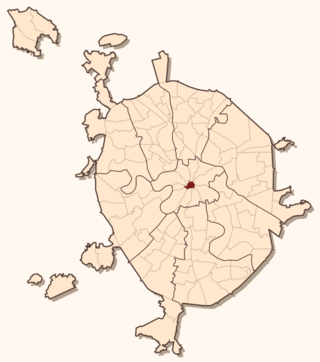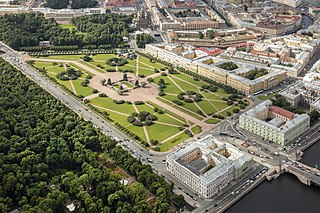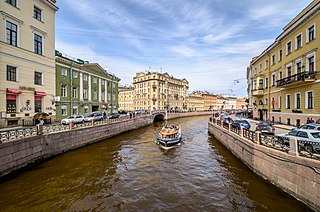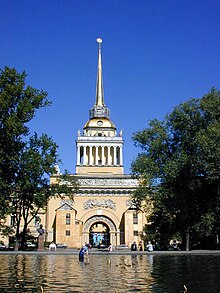
Nevsky Prospect is a main street located in the federal city of St. Petersburg in Russia. Its name comes from the Alexander Nevsky Lavra, the monastery which stands at the eastern end of the street, and which commemorates the Russian hero Prince Saint Alexander Nevsky (1221–1263). Following his founding of Saint Petersburg in 1703, Tsar Peter I planned the course of the street as the beginning of the road to Novgorod and Moscow. The avenue runs from the Admiralty in the west to the Moscow Railway Station and, after veering slightly southwards at Vosstaniya Square, to the Alexander Nevsky Lavra.

Kitay-gorod, also referred to as the Great Possad in the 16th and 17th centuries, is a cultural and historical area within the central part of Moscow in Russia, defined by the remnants of now almost entirely razed fortifications, narrow streets and very densely built cityscape. It is separated from the Kremlin by the Red Square. Kitay-gorod does not constitute a district (raion), as there are no resident voters, thus, municipal elections are not possible. Rather, the territory has been part of Tverskoy District, and the Central Administrative Okrug authorities have managed the area directly since 2003.

Vasilyevsky Island is an island in St. Petersburg, Russia, bordered by the Bolshaya Neva and Malaya Neva Rivers in the south and northeast, and by Neva Bay of the Gulf of Finland in the west. Vasilyevsky Island is separated from Dekabristov Island by the Smolenka River. Together they form the territory of Vasileostrovsky District, an administrative division of Saint Petersburg.

The Field of Mars is a large square in the centre of Saint Petersburg. Over its long history it has been alternately a meadow, park, pleasure garden, military parade ground, revolutionary pantheon and public meeting place.

The Moyka is a short river in Saint Petersburg which splits from the Neva River. Along with the Neva, the Fontanka river, and canals including the Griboyedov and Kryukov, the Moyka encircles the central portion of the city, effectively making that area an island or a group of islands. The river derives its name from the Ingrian word Muya for "slush" or "mire", having its original source in former swamp. It is 5 kilometres (3 mi) long and 40 metres (130 ft) wide.

The Palace Embankment or Palace Quay is a street along the Neva River in Central Saint Petersburg which contains the complex of the Hermitage Museum buildings, the Hermitage Theatre, the New Michael Palace, the Saltykov Mansion and the Summer Garden.

The Admiralty Embankment or Admiralty Quay is a street along the Neva River in Central Saint Petersburg, named after the Admiralty Board. It is a short embankment built at the former site of the 18th-century Admiralty Shipyard. Between 1919 and 1944 the street was known as Roshal Embankment, named after the revolutionary S. G. Roshal.

The English Embankment or English Quay is a street along the left bank of the Bolshaya Neva River in Central Saint Petersburg. It has been historically one of the most fashionable streets in Saint Petersburg, and in the 19th century was called by the French term, Promenade des Anglais. It was from the English Embankment that at 2 am on October 25, 1917, the gunshot from the Aurora sent the signal to storm the Winter Palace during Russian Revolution.

Sadovaya Street or Garden Street is a major thoroughfare in Saint Petersburg, Russia, passing through the historic city center.

Admiralteysky Municipal Okrug is a municipal okrug of Admiralteysky District of the federal city of St. Petersburg, Russia. Population: 22,634 (2010 Census); 30,533 (2002 Census).

Saint Isaac's Square or Isaakiyevskaya Ploshchad, known as Vorovsky Square between 1923 and 1944, in Saint Petersburg, Russia is a major city square sprawling between the Mariinsky Palace and Saint Isaac's Cathedral, which separates it from Senate Square. The square is graced by the equestrian Monument to Nicholas I.
The appearance of Saint Petersburg includes long, straight boulevards, vast spaces, gardens and parks, decorative wrought-iron fences, monuments and decorative sculptures. The Neva River itself, together with its many canals and their granite embankments and bridges help to give the city its particular ambience.

Petrogradsky Island or Petrograd Island is the third-largest island in the Neva River delta in Saint Petersburg, Russia. Along with Zayachy Island, Aptekarsky Island, and Petrovsky Island, it constitutes the Petrogradskaya Side. It is the administrative center of the Petrogradsky District and hosts a number of universities and research centers, as well as cultural, historical, and recreational facilities.

Saint Petersburg, formerly known as Petrograd and later Leningrad, is the second-largest city in Russia after Moscow. It is situated on the River Neva, at the head of the Gulf of Finland on the Baltic Sea. The city had a population of 5,601,911 residents as of 2021, with more than 6.4 million people living in the metropolitan area. Saint Petersburg is the fourth-most populous city in Europe, the most populous city on the Baltic Sea, and the world's northernmost city of more than 1 million residents. As the former capital of Imperial Russia, and a historically strategic port, it is governed as a federal city.

The Alexander Garden lies along the south and west façades of the Russian Admiralty in St. Petersburg, parallel to the Neva River and Admiralty Quay, extending from Palace Square in the east to St. Isaac's Cathedral in the west. The English park is named after Alexander II of Russia who ordered some 52 species of trees to be planted there. It was formerly known as the Admiralty Boulevard, the Admiralty Meadow, and the Labourers Garden.
The following is a timeline of the history of the city of Saint Petersburg, Russia.

Saint Petersburg – second-largest city in Russia. An important Russian port on the Baltic Sea, it has the status of a federal subject. Its name was changed to "Petrograd" in 1914, then to "Leningrad" in 1924, and back to Saint Petersburg in 1991.


















